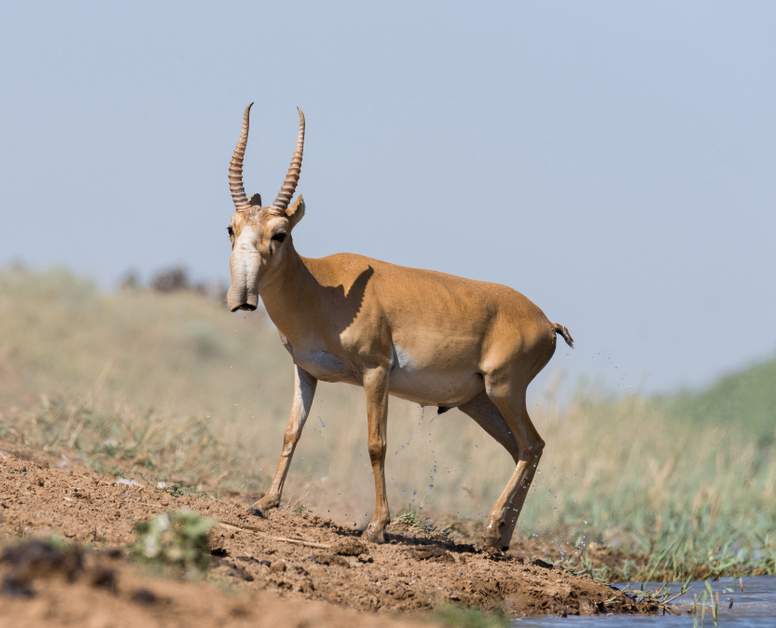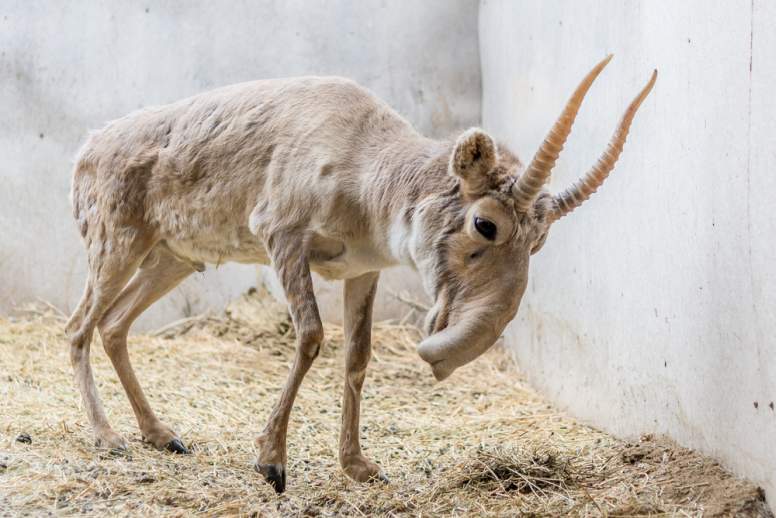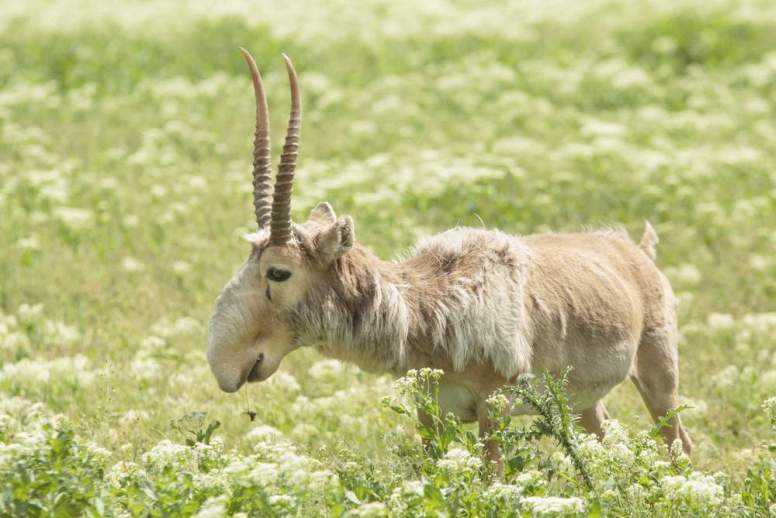Saiga Antelope Profile
The Saiga Antelope originally inhabited a vast region of the Eurasian steppe zone. Their range once went from the foothills of the Carpathian Mountains and Caucasus to Dzungaria and Mongolia.
The dominant species of this animal is currently found in just one location in Russia and three areas in Kazakhstan. Some of the animals located in the Ustiurt region of Kazakhstan migrate south to Uzbekistan and as far as Turkmenistan in winter.
The Saiga antelope is extinct in China and Mongolia. Due to extensive hunting in Romania and Moldova, it is extinct in those areas as well. A Mongolian subspecies is all that remains in Mongolia.
They have an unusual hanging nose, which makes them look like a camel, although they are goat-sized, and male saigas have horns.

Saiga Antelope Facts Overview
| Habitat: | Grasslands, semi-desert, woodlands |
| Location: | Russia, Kazakhstan, Mongolia |
| Lifespan: | 5 – 12 years |
| Size: | 100 – 140 cm (39 – 55 inches) |
| Weight: | 25 – 70 kg (57 – 152 lbs) |
| Color: | Sandy, beige, white, brown |
| Diet: | Plants, herbs, shrubs |
| Predators: | Wolves, foxes, feral dogs, birds of prey |
| Top Speed: | 48 mph (80 kph) |
| No. of Species: |
1 |
| Conservation Status: |
Critically Endangered |
The saiga antelope typically forms rather large herds that will graze in various landscapes including steppes, semi-desert, grasslands and sometimes open woodlands.
Their diet consists mostly of several plant species as well as some that are poisonous to other animals. Their range is also vast as these animals can cover great distances. They will swim across rivers, but tend to shy away from steep or rugged regions.
Saiga antelopes have a head and body length of between 3 and 5.6-feet. Their tail can be between 2.4 and 5.2-inches in length and they can have a shoulder height of 2 to 2.6-feet. Depending on the sex and age, saiga antelopes can weigh between 57 and 152-pounds.
They have a very unusual looking face with a large, inflatable nose that makes them look a bit like a camel although the body structure of the saiga strongly suggests a similarity to small sheep. Saiga antelope also have long, spindly legs that aid in their speedy travel.
Their coat is a cinnamon buff to yellowish red in color and somewhat lighter on the under belly. During the summer, the coat is thinner and light while during winter it becomes thick and denser. It is also almost twice as long in the winter and almost 70% thicker than the summer coat. Their waxy-colored horns are semi-translucent and grow to between 8 and 10-inches in length. They contain several rings around the bottom two-thirds of their length.
The Memorandum of Understanding (MoU) Concerning Conservation, Restoration and Sustainable Use of the Saiga Antelope was concluded and put into effect in September 2006. It was under the auspices of the Convention on Migratory Species of Wild Animals (the Bonn Convention).
The decline in the saiga antelope population has been identified as one of the fastest population collapses of large mammals in recent memory. The MoU was developed to assist in reducing the exploitation of the animal and to restore its population in Central Asia.
Interesting Saiga Antelope Facts
1. Their inflatable, humped nose which hangs over its mouth and points downwards helps filter out dust kicked up by the herd.
It also helps cool the animals blood quickly. They also have a large head that has a bulging shape.

2. Only male Saiga Antelope have horns.
These horns are thick, wax coloured, slightly translucent and can grow as long as 40 cm (15 inches) in length.
3. These animals are known for extensive migratory habits.
The saiga antelope is much like the Mongolia gazelle in that they will travel great distances to avoid any kind of natural disaster.
4. A number of different predators threaten the existence of these creatures.
In addition to hunting by man, the saiga is vulnerable to wolves. Younger saigas are the target of foxes, ravens, dogs, steppe eagles and golden eagles.

5. The use of the saiga antelope horn for medicinal purposes has greatly impacted the animal population.
Traditional Chinese medicine has been responsible for the demand for saiga antelope horns. The horns sell for as much as $150 USD and poachers and smugglers have contributed to the extinction of this animal in China.
6. Although it is probably not a record, Chinese customs officials at the Kazakh Border uncovered a huge shipment of saiga horns in 2014.
A total of 66 cases were seized containing a total of 2,351 saiga antelope horns. The estimated value at the time was over $11-million USD. That would have made each horn worth just over $4,600 USD.
7. The hunting of saigas has gone on for many centuries.
In fact, estimates point to saiga antelope hunting dating back as far as prehistoric times when hunting was the primary source of food collection.
8. The saiga antelope has commercial value in the consumer marketplace.
In addition to horns, saiga antelope meat and skin are exported annually from Kazakhstan.
9. Saiga horn, known as comu antelopis, has many uses in traditional Chinese medicine.
The horn is used as an extract or powder additive which is mixed into elixirs, drinks and ointments for various remedies.
10. The banning of rhinoceros horn in 1993 has aided the shift in use to saiga horn.
Although the rhinoceros horn has a greater value, following the banning of its use, saiga horn became the logical and affordable alternative in many recipes used in traditional Chinese medicine.
11. Although the hunting and trade of saiga antelope horns is considered illegal, it still happens.
In fact, horn products are easy to locate and purchase in a variety of venues and businesses. They are also sold openly and publicly.
12. The meat of the saiga is popular.
Not only is it comparable to that of lamb, saiga meat is said to be both nutritious and delicious. It is also not that difficult to locate recipes for cooking the meat.
13. Over a 34 year period, massive numbers of saiga antelope were hunted and killed for their meat.
Between 1955 and 1989 over five million saiga antelope were killed in Kazakhstan. It totaled well over 87-thousand tones of meat.
14. The skin of the saiga is also valuable.
About 45 to 80 square decimeters of skin can come from a single saiga antelope, depending on age and sex. The skin is used for producing suede as well as box calf.

15. The saiga has varying degrees of sensitivity to their senses.
These animals have both poor hearing and a poorly developed sense of smell. However, their eyesight is considered to be acute. In fact, the saiga can see danger as far as a kilometer away.
Saiga Antelope Fact-File Summary
Scientific Classification
| Kingdom: | Animalia |
| Phylum: | Chordata |
| Class: | Mammalia |
| Order: | Artiodactyla |
| Family: | Bovidae |
| Subfamily: | Antilopinae |
| Genus: | Saiga |
| Species Name: |
Saiga Tatarica |
